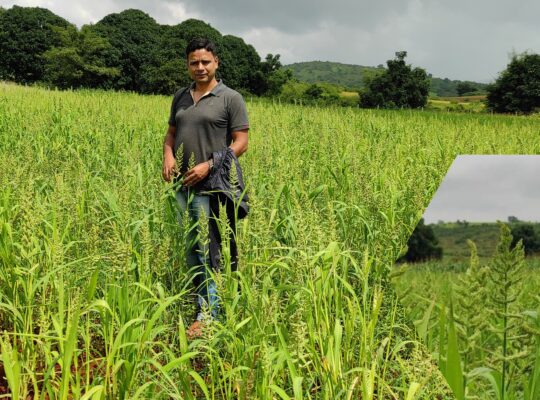Finger millet (Eleusine coracana), an ancient and hardy cereal crop, has played a vital role in the diets of many indigenous tribal communities across India. In the state of Odisha, the tribal populations have cultivated and cherished finger millet for generations, integrating it into their culinary traditions. This study delves into the diverse and time-honored recipes revolving around finger millet within the tribal communities of Odisha. Through meticulous documentation and analysis, I could uncover the rich tapestry of flavors, techniques, and cultural significance associated with finger millet-based dishes.
Introduction:
Finger millet, often referred to as “mandia” in the local dialects, holds a unique place in the lives of Odisha’s tribal populations. Its resilience in the face of adverse conditions, coupled with its exceptional nutritional profile, has sustained these communities for centuries. As urbanization and modernization encroach upon traditional ways of life, it becomes increasingly crucial to document and preserve the culinary heritage rooted in finger millet.
Methods:
MY study engaged in extensive fieldwork, collaborating closely with tribal farmers, culinary experts, and community members. Semi-structured interviews, participatory observations, and recipe documentation formed the core of my data collection methods. The study spanned Dasamantpur Block in Koraput district in Odisha where finger millet cultivation remains prominent.
Results:
- Diversity in Finger Millet Dishes: The study unearthed a plethora of finger millet recipes, ranging from staple porridges like “Mandia Jau” to delectable snacks such as “mandia Pitha.” These dishes exhibited remarkable diversity in preparation methods, ingredients, and regional variations.
- Traditional Cooking Techniques: I could observe that many finger millet recipes involved time-honored techniques such as fermentation, sprouting, and pounding, highlighting the ingenuity of tribal culinary practices.
- Cultural Significance: Finger millet-based dishes often held special cultural and ritualistic significance within the tribes. They were frequently prepared during festivals, ceremonies, and community gatherings, emphasizing the crop’s intrinsic link to the tribal way of life.
Finger Millet Recipes of the Tribals:
From the analysis of the data, it is found that Mandia Jau (Finger Millet Porridge/Gruel) is consumed by 38% people. For making Mandia Jau, it hardly takes 10-15 minutes. The flour is taken in a bowl and a small amount of water is added to it and a semi-liquid mix is made by mixing it properly and ensuring no lumps are left. In the mean time, water is taken in a cooking pot and after the water boils, the semi liquid is put into it. With a ladle it is continuously stirred for about 2-3 minutes and finally the flame is off and it is allowed to cool down.
Apart from Mandia Jau, the next Finger Millet recipe that is made by tribals is the Mandia Tampa (1 part of rice is mixed with 2 part of flour). Generally, broken rice is preferred to make this recipe. When the tribal people go for work in their field, they carry Mandia Tampa in jar to have it during lunch time.
Pitha (home-made pan cakes/dumplings) are consumed occasionally. It is made during festival or when any guest comes to their home. Pithas are made by mixing Finger Millet flour with jaggery, chilli, little amount of water and salt as per taste. Basically, a dough is made. Then the dough is flattened and wrapped in the banana leaves, turmeric leaves or jackfruit leaves and roasted on circular griddle made of iron or clay in low flame. When one side is cooked, the other side is flipped and the pitha is ready to consume.
The other interesting millet recipes are Mandia Anda( a round ball shaped made with Ragi flour and broken rice), Mandia Kandul Raav( Ragi flour with some soaked whole arhar dal with masala), Mandia Sukua Raav (Ragi flour with dry fishes with some masala).
Millet recipes are also made with Little Millet and Foxtail Millet. But it is slowly disappearing from their diet. It is due to lot of drudgery is involved in processing or removing the husk from it. The tribal women say, it takes about one hour to process one kilogram of millets. If they want to make any dish out of Little Millet and Foxtail Millet, they buy the processed millets from market and that too paying high cost, around Rs.80-120 per kilogram.
Discussion:
The study’s findings underscore the importance of preserving indigenous knowledge about finger millet recipes. As these communities face changing dietary preferences and nutritional challenges, there is a need to promote the consumption of finger millet-based dishes for their health benefits.
Furthermore, the documentation of these recipes not only provides valuable insights into tribal culinary traditions but also offers opportunities for promoting sustainable farming practices and boosting the nutritional security of these communities.
Conclusion:
Finger millet recipes among the tribal communities of Odisha represent a fascinating and multifaceted aspect of their cultural heritage. As we move forward, it is essential to recognize the significance of these recipes in maintaining dietary diversity, preserving traditions, and promoting the cultivation of this resilient cereal crop.
This study serves as a testament to the importance of documenting and celebrating the culinary diversity that finger millet brings to the table. It is our hope that these findings will contribute to the appreciation and preservation of these treasured recipes and their cultural relevance.
Acknowledgments:
I extend my heartfelt gratitude to the tribal communities of Odisha for graciously sharing their culinary wisdom and traditions with me. Without their invaluable insights and cooperation, this study would not have been possible.
Benefits of Millets: 5 Best Millets for Diabetes


